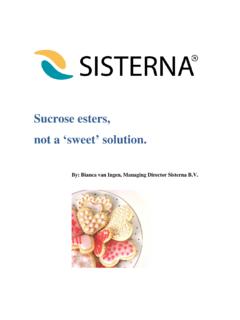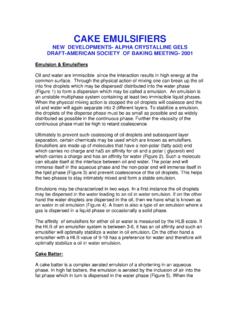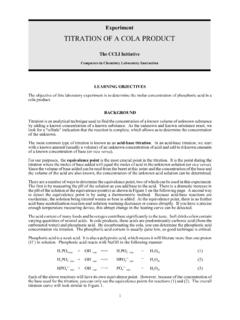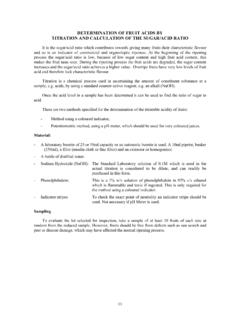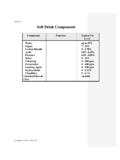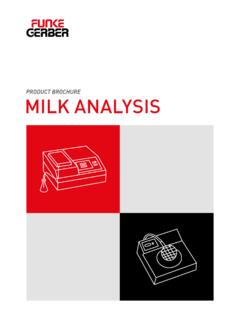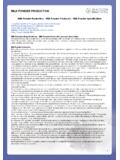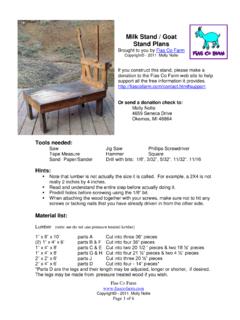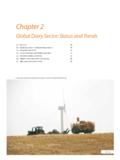Transcription of Furthering Families - Fantastic Flavours
1 Furthering Families milk pasteurizationGuarding against diseaseMilk, a natural liquid food, is one of our most nutritionally complete foods, addinghigh-quality protein, fat, milk sugar, essential minerals, and vitamins to our , milk contains bacteria that when improperly handled may createconditions where bacteria can multiply. Most of the bacteria in fresh milk from ahealthy animal are either harmless or beneficial. But, rapid changes in the health of ananimal, or the milk handler, or contaminants from polluted water, dirt, manure,vermin, air, cuts, and wounds can make raw milk potentially do microorganisms enter the milk supply?Our environment contains an abundance of microorganisms that find their way to thehair, udder, and teats of dairy cows and can move up the teat canal.
2 Some of thesegerms cause an inflammatory disease of the udder known as mastitis while othersenter the milk without causing any disease symptoms in the animal. In addition,organisms can enter the milk supply during the milking process when equipment usedin milking, transporting, and storing the raw milk is not properly cleaned and milk and milk products have the potential to transmit pathogenic (disease- causing)organisms to humans. The nutritional components that make milk and milk productsan important part of the human diet also support the growth of the organisms. Drinking raw milk causes foodborne illness, and dairy producers selling or giving rawmilk to friends and relatives are putting them at are common pathogens in milk ?Illnesses from contaminated milk and milk products have occurred worldwide sincecows have been milked.
3 In the 1900s it was discovered that milk can transmittuberculosis, brucellosis, diphtheria, scarlet fever, and Q-fever (a mild diseasecharacterized by high fever, chills, and muscular pains) to humans. Fortunately, thethreat of these diseases and the incidence of outbreaks involving milk and milkproducts has been greatly reduced over the decades due to improved sanitary milkproduction practices and pasteurization. Salmonella. Salmonellosis is the most common disease transmitted in raw milk . This organism is shed in the feces of cattle and picked up on the animals hair orteats. Many strains of Salmonella can cause foodborne illness in humans, and allstrains exhibit the same symptoms such as gastroenteritis (vomiting and diarrhea).Pasteurization destroys the Salmonella organism, and although pasteurized milk ,MSU is an affirmative-action, equal-opportunity State University Extensionprograms and materials are open to all without regard to race, color, national origin, gender,religion, age, disability, political beliefs, sexual orientation, marital status, or family milk , and cheese have been implicatedin salmonellosis outbreaks, in these cases, thepasteurized milk was contaminated during furtherprocessing.
4 Listeria monocytogenes. This widespreadorganism is found principally in soil. Listeriosis in humans may cause serious illness,and is especially dangerous to pregnantwomen, causing stillbirths or infant death soonafter birth. Pasteurization inactivates Listeriamonocytogenes. Yersinia enterocolitica. This commonorganism has been found in many foods ofanimal origin including milk , cheese, and red. Yersinia, found in streams, lakes, and wells,spreads from the water to warm-bloodedanimals. The most common symptom ofyersinosis is gastroenteritis and mimics thesymptoms of appendicitis. Yersiniaenterocolitica is destroyed by pasteurization. Campylobacter jejuni. This organism,isolated in raw milk and meat, can causemastitis in dairy cattle. It has also been isolatedin the feces of many species including dogs,cats, rodents, cattle, sheep, swine, and include vomiting, cramps, bloodydiarrhea, mild enteritis, or severe who have recovered from thedisease may suffer a relapse.
5 Campylobacterjejuni is destroyed by pasteurization. Staphylococcus aureus is a common causeof mastitis in dairy cattle and can enter the milksupply from sores on the teats of cows or fromthe hands and nasal discharges of dairy farmersand workers. The Staphylococcus organismproduces an enterotoxin (toxins causingvomiting and diarrhea) in raw milk when it isheld at temperatures above 50 degreesFahrenheit. Sufficient amounts of enterotoxinin foods can cause illness. The incidence ofstaphylococcal intoxication has been greatlyreduced by pasteurization. Escherichia coli 0157: H7. Recentstudies show that young dairy cattle are hostto E-coli and fecal contamination is a likelysource of E-coli in raw milk . It can causehemorrhagic colitis and hemolytic uremicsyndrome in humans.
6 milk should be storedat temperatures below 40 degreesFahrenheit to inhibit the growth ofEscherichia coli 0157: H7. Temperatureabuse during holding and shipping can causesignificant growth of the destroys this : Department of Agriculture, (1981), USDA Fact Sheet Number by Cindy Brock, Extension Educator, Food Safety Area of ExpertiseTeam, Cheboygan, Montmorency, and Presque Isle Counties, Michigan StateUniversity ExtensionReviewed by John Partridge, , Professor, Food Science and Human Nutrition,Michigan State University Furthering Families milk pasteurizationPasteurization and handling requirementsPasteurization, named for Louis Pasteur who developed the process for other foods, isa moderate but exact heat treatment of milk . Pasteurization kills bacteria that producedisease and retards spoilage in is pasteurization?
7 Pasteurization destroys most disease producing organisms and limits fermentation inmilk, beer, and other liquids by partial or complete sterilization. The pasteurizationprocess heats milk to 161 degrees Fahrenheit (63 degrees centigrade) for 15 seconds,inactivating or killing organisms that grow rapidly in milk . Pasteurization does notdestroy organisms that grow slowly or produce pasteurization destroys many microorganisms in milk , improper handling afterpasteurization can recontaminate milk . Many dairy farms use a home-pasteurizingmachine to pasteurize small amounts of milk for personal use. Raw milk can also bepasteurized on the stovetop. Microwaving raw milk is not an effective means ofpasteurization because of uneven heat distribution.
8 For more information onpurchasing and caring for home pasteurization machines, contact your countyExtension temperature (UHT) processing destroys organisms more effectively and themilk is essentially sterilized and can be stored at room temperature for up to 8 weekswithout any change in are the requirements for safe handling of milk ?The requirements for proper pasteurization and handling of milk are: A potable water supply and proper dispensing system must be available toavoid contamination. A pure hot and cold water supply for the animals health, and for proper cleaning of the animals, milk handlers and inspection and maintenance of the system is necessary. Clean and healthy animals, clean hands, and clean utensils are animals hair should be clipped regularly around the flanks and udder tokeep it from collecting dirt.
9 Milkers should walk their hands and the udder withclean water or use an approved germicidal solution before milking. milk fromdiseased animals or those under antibiotic treatment may not be used. AllMSU is an affirmative-action, equal-opportunity State University Extension programsand materials are open to all without regard to race, color, national origin, gender, religion, age, disability,political beliefs, sexual orientation, marital status, or family and utensils should be cleanedimmediately after use. Stainless steel utensilsare preferred since they are durable and easy toclean. Rapid cooling, cold storage, properpasteurization, and clean cold storage ofpasteurized are necessary for the preventionof foodborne illness. milk must be promptlycooled to 40 F (4 C) or less and stored in aclosed container before and after pasteurizationto maintain the quality and flavor of the should be taken not to transfer barnyard dirt fromthe bottom or sides of the storage container to thecountertop or to utensils in the pasteurization andstorage not mix fresh milk with previously cooked milkunless you plan to pasteurize the entire do I pasteurize milk ?
10 milk must be heated, with agitation, in such a way thatevery particle of the milk , including the foam, receivesa minimum heat treatment of 150 F (66 C)continuously for 30 minutes or 161 F (72 C) for 15seconds. The temperature should be monitored withan accurate metal or protected glass operations commonly use a high-temperature, short-time process in which the milk isheated to 170 F (77 C) for 15 seconds and thencooled immediately to below 40 F (4 C) to increasestorage life without any noticeable flavor change inthe of fluid milk has very specificrequirements for time and temperature as listed inthe PasteurizationRequirements for Fluid MilkTemperatureTime 150 F (66 C)30 minutes(vat pasteurization) 161 F (72 C)15 seconds(high temperature, short-time pasteurization) 191 F (89 C)1 second 212 F (100 C) secondReferencesNamminga, Kelly, (1999), Health Risks of Drinking Raw(Unpasteurized)
